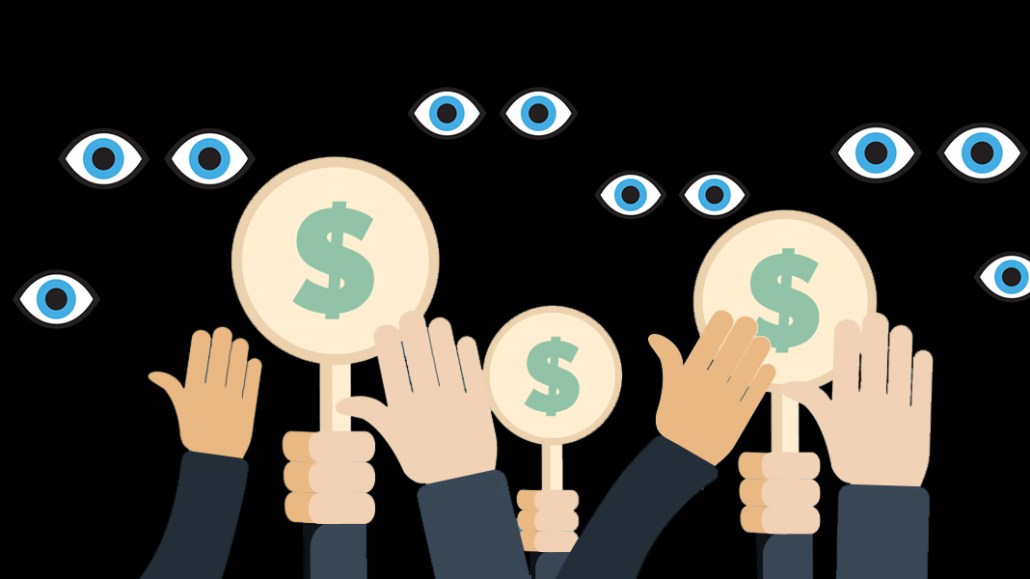Register by Jan 13 to save on passes and connect with marketers from Uber, Bose and more

This article is a WTF explainer, in which we break down media and marketing’s most confusing terms. More from the series →
Agencies love deals whereby the more media they buy in bulk the less they pay per unit but have found those discounts scarce in programmatic. In post-auction discounts, however, agencies may have found the winning ticket as they let agencies rely more on their buying power to secure those deals just as they would for TV or radio.
With these deals set to become more commonplace as agencies try to exert more control over how programmatic auctions work, here’s a primer on how they work and who stands to benefit from them.
Let’s start with the basics
Post-auction discounts happen when a publisher agrees to make money off of winning bids for certain impressions from an agency. So if an agency wins an impression in an auction at one price, the actual fee they pay will be lower once the discount kicks in. The theory behind the deal isn’t new. Agencies already have similar, direct deals with specific publishers in place, where both have agreed to trade impressions for an agreed fee and amount of spend in private marketplaces. What’s different with post-auction discounts is they happen via an ad tech vendor like a supply-side platform and tend to be focused on inventory bought from the open marketplace. Those discounts can range anywhere between 1% and 50%, according to Index Exchange, which has built a tool for agencies to strike those deals.
“We’ve had a few of the agencies we work with mention these discounts to us,” said one ad tech exec on condition of anonymity for fear of jeopardizing those deals. “They’re telling us they want the commercial benefits of being big buyers to apply to the open marketplace.”
Why do agencies need SSPs to be involved?
When an advertiser negotiates a discount with a publisher it’s a little complicated but possible to respect that preferred price in private marketplaces. It’s harder, however, to strike those sorts of deals in the open marketplace where Google’s ad server, which is the only way publishers can get access to the ad exchange that has historically delivered the highest prices, doesn’t work so well with independent SSPs like Index Exchange. In effect, post-auction discounts are a workaround by the SSP for publishers to be able to pass on discounts to agencies.
Rubicon and Xandr are other ad tech vendors that have talked to agencies about building tools that allow these sorts of discounts to be set.
If post-auction discounts are set at an SSP level is that bad news for publishers?
Not necessarily. In fact, it’s the publisher that sets the discount that GroupM’s buyers get on bids made via the Index Exchange SSP, for example.
Those discounts are for specific impressions so are neither applicable to all GroupM’s transactions with the publisher or all its deals handled by Index. In other words, the publisher sets those discounts and decides when they kick in.
“The feature is designed to give buyers and publishers the same ability to create financial agreements in programmatic that they do in other media transactions,” said Michael McNeeley, vp of product at Index Exchange. These discounts are controlled and set by the publisher and they will help them incentivize spend.
So what’s the catch?
On the one hand, these deals give publishers another way to convince buyers to spend more with them in return for discounts. The risk, though, is that the agencies buy the same amount of impressions with the publisher but pay less for it. Some media execs argue that these discounts work on the basis that both the SSP and the publisher absorb the difference between the winning bid and the actual price paid for an impression. Essentially, both ad tech vendors and publishers must commit to losing some of the margin made on each successful bid from the agency to ensure they spend more money with them and less through their rivals.
More in Media

Why publishers are building their own creator networks
Publishers are forming creator networks to regain control, combat traffic declines, and reach audiences shifting toward influencers.

The accidental guardian: How Cloudflare’s Matthew Prince became publishing’s unexpected defender
Cloudflare’s day job is fending off botnets and nation-state cyberattacks, not debating how Google and other AI firms crawl publisher sites.

A timeline of the major deals between publishers and AI tech companies in 2025
Here’s a list of all the major deals signed between publishers and AI tech companies in 2025.








